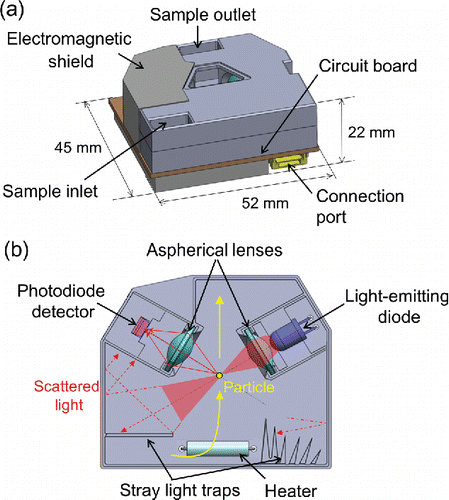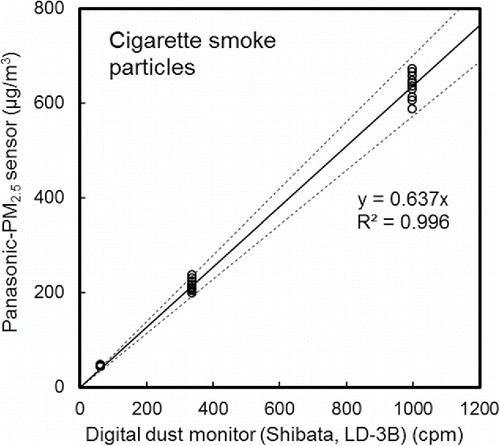ABSTRACT
A new palm-sized optical PM2.5 sensor has been developed and its performance evaluated. The PM2.5 mass concentration was calculated from the distribution of light scattering intensity by considering the relationship between scattering intensity and particle size. The results of laboratory tests suggested that the sensor can detect particles with diameters as small as ∼0.3 µm and can measure PM2.5mass concentrations as high as ∼600 µg/m3. Year-round ambient observations were conducted at four urban and suburban sites in Fukuoka, Kadoma, Kasugai, and Tokyo, Japan. Daily averaged PM2.5 mass concentration data from our sensors were in good agreement with corresponding data from the collocated standard instrument at the Kadoma site, with slopes of 1.07–1.16 and correlation coefficients (R) of 0.90–0.91, and with those of the nearest observatories of the Ministry of the Environment of Japan, at 1.7–4.1 km away from our observation sites, with slopes of 0.97–1.23 and R of 0.89–0.95. Slightly greater slopes were observed in winter than in summer, except at Tokyo, which was possibly due to the photochemical formation of relatively small secondary particles. Under high relative humidity conditions (>70%), the sensor has a tendency to overestimate the PM2.5 mass concentrations compared to those measured by the standard instruments, except at Fukuoka, which is probably due to the hygroscopic growth of particles. This study demonstrates that the sensor can provide reasonable PM2.5 mass concentration data in urban and suburban environments and is applicable to studies on the environmental and health effects of PM2.5.
Copyright © 2018 American Association for Aerosol Research
EDITOR:
1. Introduction
Aerosol particles have important roles in the earth's climate and air quality (Boucher, Citation2015; Seinfeld and Pandis, Citation2016). It has been recognized that fine particulate matter, such as PM2.5 (airborne particles with aerodynamic diameters less than 2.5 μm), negatively impacts human health through heart disease, stroke, lung cancer and chronic obstructive pulmonary disease, and this results in the premature mortality of many people (Lelieveld et al. Citation2015; Zhang et al. Citation2017). Therefore, many countries have established air quality standards for PM2.5 to regulate major sources.
As standard instruments for the continuous monitoring of PM2.5 mass concentrations, tapered element oscillating microbalance, beta attenuation, and a hybrid of beta attenuation and light scattering, have been widely used in conjunction with an impactor or cyclone (Kulkarni et al. Citation2011; EPA Citation2013). The PM2.5 is expected to be heterogeneously distributed in both indoor and outdoor atmospheres because of its many direct emission sources and secondary formation processes. High-density multi-point observations are needed to understand the source, transport, and sink of PM2.5 and its effects on climate, air quality, and human health. However, the above standard instruments are not suitable for these observations because of their relatively high cost, large size, high power consumption, and low temporal resolution (typically >1 h). The development and application of a low-cost palm-sized PM2.5 sensor, which can measure PM2.5 mass concentrations precisely and accurately, is important to achieve high-density multi-point observations (Kaufman et al. Citation2014; Lewis and Edwards Citation2016; Jiao et al. Citation2015, Citation2016; Mueller et al. Citation2016; Patel et al. Citation2017). A palm-sized PM2.5 sensor with low power consumption and high temporal resolution can also be applied to mobile measurements for personal exposure studies (Steinle et al. Citation2015) and to airborne measurements using balloon sonde and unmanned aircraft (Alvarado et al. Citation2015).
Optical instruments based on the detection of light scattering from particles have been used for measurements of PM2.5 mass concentrations, especially for monitoring work place environments (Kulkarni et al. Citation2011). Recently, optical sensors have drawn more attention because of their potential to reduce their size and cost. Studies on the development and/or evaluation of a variety of sizes (from palm-sized to desk-top) of optical PM sensors, including TSI DustTrak, TSI Sidepak, Thermo Scientific DataRAM, the Dylos DC series, Met One Aerocet, the Plantower PMS series, the Shinyei PPD series, the Samyoung (Syhitech) DSM series, and the Sharp GP and DP series, have been reported (Wallace et al. Citation2011; Northcross et al. Citation2013; Holstius et al. Citation2014; Williams et al. Citation2014; Dacunto et al. Citation2015; Austin et al. Citation2015; Wang et al. Citation2015; Gao et al. Citation2015; Jiao et al. Citation2015, Citation2016; Sousan et al. Citation2016; Han et al. Citation2016; Manikonda et al. Citation2016; Zikova et al. Citation2017; Kelly et al. Citation2017). However, the linearity and/or accuracy of some currently available sensors are not necessarily high under specific conditions, especially when the sensor was designed to detect light scattering from particle ensembles. Non-negligible contributions of particles with diameters smaller than the detectable size limit of the sensors (typically, 0.5 μm [Sousan et al. Citation2016; Manikonda et al. Citation2016; Zikova et al. Citation2017]) can also be a source of uncertainty. Further studies on the development of new high-performance sensors, as well as validation of these sensors, are necessary (Snyder et al. Citation2013; Lewis and Edwards Citation2016).
In the present study, a new palm-sized optical PM2.5 sensor (hereafter referred to as Panasonic-PM2.5 sensor) has been developed. For accurate measurement of PM2.5 mass concentrations, the sensor is designed to be able to estimate particle sizes from the distributions of light scattering intensities from single particles and to detect small particles with diameter as small as ∼0.3 μm by reducing background noise. The performance of the sensor is evaluated based on laboratory and field tests.
2. Details of the PM2.5 sensor and laboratory tests
2.1. Design of the PM2.5 sensor
shows a schematic diagram of the Panasonic-PM2.5 sensor developed in the present study. The size of the sensor is 52 mm × 45 mm × 22 mm, including a printed circuit board with a connection port for data processing and a power supply. Aerosol particles flow into the sensor via an updraft generated by a heater inside the sampling inlet. Although the sampling flow rate was not directly controlled, the sensor has been designed to produce a constant temperature gradient around the heater. Using computational fluid dynamics, the average flow rate in the detection region was estimated to be 65 mm/sec. Around the center of the sensor, the aerosol particles are irradiated with light, which is emitted from a light-emitting diode (λ = 625 nm) and focused with an aspherical lens. The scattered light is focused with another aspherical lens and detected with a photodiode detector. Stray light traps are also deployed in the sensor to detect weaker scattered light from smaller particles by reducing background noise. The number concentrations in each of three particle size bins are estimated from the distribution of light scattering intensities from single aerosol particles and then the PM2.5 mass concentration is calculated as described in the following section. The power consumption of the sensor is approximately 0.4 W at 5 V.
2.2. Calibration to determine PM2.5 mass concentration
Calibration of the light scattering signals of the Panasonic-PM2.5 sensor was conducted using nearly monodisperse polystyrene latex (PSL) particles (Thermo Fisher Scientific). The procedures for preparing nearly monodisperse PSL particles were the same with as those in our previous studies (Nakayama et al. Citation2010, Citation2015; Nakagawa et al. Citation2016). The PSL particles were nebulized using an atomizer with synthetic air and were dried using a diffusion dryer with silica gel. Nearly monodisperse particles were selected by passing these particles through a differential mobility analyzer (DMA, TSI, model 3081) and an aerosol particle mass analyzer (APM, Kanomax, model 3601). These particles were introduced into a box containing the PM2.5 sensors and a condensation particle counter (CPC, TSI, model 3772). The PM2.5 mass concentration was calculated using the particle size of PSL and the particle number density measured with the CPC, assuming the density of PSL to be 1.05 g/cm3.
To estimate the PM2.5 mass concentration accurately, the sensor was required to detect a larger fraction of the particles contributing to the total mass concentration. shows examples of temporal variations in light scattering signals detected by the sensor when measuring PSL particles with diameters of (a) 0.296 and (b) 0.498 μm. The number concentrations of PSL particles with diameters of 0.296 and 0.498 μm measured by the CPC are approximately 17 and 13 particles/cm3, respectively. The observed frequencies of particles (1–2 particle/sec) are reasonable if the region of detection of the particles is assumed to be a cube with each side having a length of 1–2 mm (considering the estimated flow rate of 65 mm/sec). The smaller observed scattering signal intensities for particles with diameter of 0.296 μm than those for particles with diameter of 0.498 μm can be explained by the smaller geometrical cross section and the smaller scattering efficiency. These results suggest that the sensor can detect particles with diameters as small as ∼0.3 μm, and this relatively low limit of the detectable particle sizes is one of the advantages of our sensor.
Figure 2. Examples of temporal variations in light scattering signals detected by the PM2.5 sensor when measuring PSL particles with diameters of (a) 0.296 and (b) 0.498 μm after passing these particles through the DMA and APM.
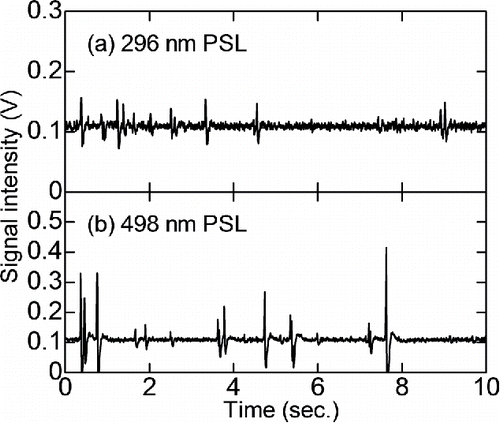
is a schematic diagram of the procedures used to calculate PM2.5 mass concentrations when measuring polydisperse sample particles. The estimation of particle size is also important for accurate measurement of the PM2.5 mass concentration under a variety of conditions, where particles may have significantly different size distributions. This sensor detects light scattering intensities from single aerosol particles. In the calibration using PSL particles, the particle size dependencies of the scattered light intensity distributions were measured and an upper limit of the scattering intensity was determined for each particle size. Here, the upper limit values of signal intensities for small, medium, and large sized particles (black, dark grey, and light grey signals, respectively, in ) are assumed to be V1, V2, and V3, respectively, and the minimum detectable scattering signal is assumed to be V0. The total particle counts per unit time for the large-sized sample particles are determined from particle counts with signal intensities between V2 and V3 and signal intensity distribution data for the large-sized PSL particles. The total particle counts for the medium-sized sample particles are then determined from particle counts with signal intensities between V1 and V2 and signal intensity distribution data for the medium-sized PSL particles. Finally, the total particle counts for the small-sized sample particles are determined from particle counts with signal intensities between V0 and V1 and signal intensity distribution data for the small-sized PSL particles. As a result, the number concentrations in each of the three particle size bins are determined. During the calibrations using PSL particles, the sensitivity factor of the sensor for each particle size was determined to reproduce the PM2.5 mass concentration based on the CPC data. Based on these data, the PM2.5 mass concentration for polydisperse sample particles is calculated. Large light scattering signals corresponding to particles with diameters larger than 2.5 μm were removed in the calculation.
Figure 3. Schematic diagram of the procedures used to calculate PM2.5 mass concentrations of polydisperse particles. Left: temporal variation of scattering signal intensity; right: particle number in each bin of signal intensities. Colors represent particles categorized in each particle size bin (black: large, dark gray: medium, light gray: small).
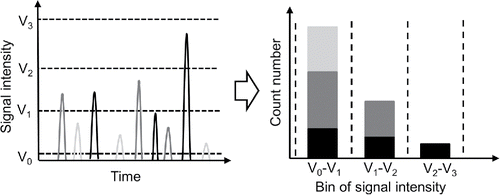
It should be noted that the output of the sensor needs to be multiplied by the ratio of the density of measured particles to that of PSL, because the PM2.5 mass concentration estimated using these procedures is an equivalent value to that of the PSL particles. Although differences in the refractive index, shape, and morphology between PSL and sample particles, which contribute to the scattering efficiency and scattering angular distribution, may also influence to the estimation of the PM2.5 mass concentration, the magnitudes of these influences are difficult to estimate and therefore are not considered in the present study.
2.3. Linearity test
The linearity of the sensor was tested using cigarette smoke particles. A test room (31 m3) with ten Panasonic-PM2.5 sensors and a digital dust monitor (Shibata, model LD-3B) was filled with cigarette smoke. Because there is no clear difference between the density of PSL particles (1.05 g/cm3) and the typical densities of cigarette smoke particles (1.0–1.3 g/cm3 [Lipowicz Citation1988; Johnson et al. Citation2014]), no additional correction to the output of the sensors was conducted before performing comparisons with the digital dust monitor. The digital dust monitor detects the total light scattering intensity from particles by passing them continuously through a laser beam. While the unit of the output of the digital dust monitor is counts per minute (cpm), this value does not indicate the number of particles but the relative total light scattering intensity from multiple particles per unit time. The output of the digital dust monitor is not expected to be saturated, even if multiple particles were passed through the laser beam. The maximum output of the dust monitor is 10000 cpm (catalog specifications).
shows a correlation plot between the 10-min averaged PM2.5 mass concentrations measured with the Panasonic-PM2.5 sensors and the output of the digital dust monitor. The solid and dashed lines in represent the result of the linear least-squares fitting and ±10% limits, respectively. Most data were within the ±10% limit from the fitting line. The 2σ variations in the PM2.5 mass concentrations from the ten sensors are 5.7%, 11.0%, and 8.6% for three different mass concentration conditions of 45, 216, and 635 μg/m3, respectively, which are average values for the ten sensors. Note that 2σ variation in the 10-min averaged PM2.5 mass concentrations obtained by each unit during repeated measurements is 4.3% (on average) and is typically less than the unit-to-unit variations. The results of the tests suggest that the sensors can measure PM2.5 mass concentrations as high as ∼600 μg/m3 without a significant saturation effect and that sensor-to-sensor variation in sensitivity is typically less than 10%.
3. Field observation tests
3.1. Sites and instruments
Year-round field observations of PM2.5 mass concentrations using the Panasonic-PM2.5 sensors were conducted at four urban and suburban sites in Fukuoka, Kadoma (near Osaka), Kasugai (near Nagoya), and Tokyo, Japan. Details of these observation sites and the observation periods are listed in . The Fukuoka site is located in an urban business area of Fukuoka city, which has a population of 1.6 million. The Kadoma site is located in a suburban industrial and residential area of Kadoma city and is ∼8 km away from the center of Osaka city, which has a population of 2.7 million. The Kasugai site is located in a suburban industrial and residential area of Kasugai city and is ∼11 km away from the center of Nagoya city, which has a population of 2.3 million. The Tokyo site is located in an urban business area of Tokyo Metropolitan, which has a population of 13.4 million. The westernmost site in Fukuoka is approximately 880 km away from the easternmost site in Tokyo. This distance is almost the same as the distance between Fukuoka and Shanghai in China. As indicated by previous studies (e.g., Aikawa et al. Citation2010; Kaneyasu et al. Citation2014; Yoshino et al. Citation2016), the Fukuoka site is expected to be strongly influenced by particles long-range transported from the Asian continent, especially during winter and spring. Aikawa et al. (Citation2010) reported that aerosol sulfate concentrations decreased in an easterly direction in Japan.
Table 1. Observation sites, periods, and instruments.
Three Panasonic-PM2.5 sensors were simultaneously used at each of the four sites. These sensors were installed in a box with louver windows and small fans, which were placed outside the 1st, 4th, 6th, and 4th floors of the buildings at the Fukuoka, Kadoma, Kasugai, and Tokyo sites, respectively. Note that the No. 12 sensor at the Tokyo site was stopped on July 10, 2015 due to trouble with insect intrusion. At the Kadoma site, simultaneous observations of PM2.5 mass concentrations using a collocated standard instrument (Thermo Fisher Scientific, model SHARP 5030), which is based on beta attenuation and light scattering measurements, were conducted. The relative humidity (RH) of the sampling air in the standard instrument was maintained at <40% by heating the sampling air at up to 75°C to avoid potential water bias.
PM2.5 mass concentration data obtained at the nearest observatories of the Atmospheric Environmental Regional Observation System (AEROS) of the Ministry of the Environment, Japan (MOEJ) (http://soramame.taiki.go.jp/) were also used for comparison. Information on these observatories and the distances from our observation sites are listed in . At these observatories, PM2.5 mass concentrations were measured using two types of standard beta attenuation monitors (DKK-TOA, model FPM-377 and Kimoto, model PM-712) (). These instruments, as well as the standard instrument (Thermo Fisher Scientific, model SHARP 5030) used at the Kadoma site, passed the “Evaluation Test for the Equivalence of Automatic Measurement Instruments” by the MOEJ. In the evaluation tests, 24 h averaged PM2.5 mass concentrations, which were measured using these continuous measurement instruments, were compared to the corresponding values determined based on offline weight measurements of filter samples maintaining at a temperature of 21.5 ± 1.5°C and a RH of 35% ± 5% for >24 h (MOEJ Citation2015; ACAP Citation2015; Akimoto Citation2017).
3.2. Comparison with the collocated standard instrument at the Kadoma site
The PM2.5 mass concentrations obtained using three Panasonic-PM2.5 sensors are compared with those obtained using the collocated standard instrument (Thermo Fisher Scientific, model SHARP 5030) to evaluate the performance of the sensor in ambient atmosphere. Considering the typical densities of ambient submicron particles, 1.2–1.8 g/cm3 (e.g., McMurry, Citation2002; Spencer et al. Citation2007; Hu et al. Citation2012; Nakayama et al. Citation2014; Yin et al. Citation2015; Zhang et al. Citation2016; Zhao et al. Citation2017), the ratio of the density of the measured ambient particles to that of PSL is assumed to be 1.3. The output of the PM2.5 sensors was multiplied by this factor before making comparisons.
Temporal variations in 24 h averaged PM2.5 mass concentrations measured using three Panasonic-PM2.5 sensors (Nos. 4–6) and the collocated standard instrument at the Kadoma site from February 2015 to December 2016 are shown in Figure S1 in the online supplemental information (SI). The PM2.5 mass concentrations measured with the sensors and the standard instrument show similar seasonal and day-to-day variations throughout the observation period. Scatter plots for these data are shown in . The 24 h averaged PM2.5 mass concentration data from the three sensors were in good agreement with corresponding data from the standard instrument with slopes of 1.07–1.16 and correlation coefficients (R) of 0.90–0.91. Of the 24 h averaged sensor data, 67% and 95% were within ±3.2 μg/m3 and ±8.7 μg/m3 of the standard instrument data, respectively. When the PM2.5 mass concentrations of the standard instrument were greater than 10 μg/m3, 67% and 95% of the 24 h averaged sensor data were within ±23% and ±62% of the standard instrument data, respectively. show correlation plots for 1 h averaged data. Strong correlations with R = 0.79–0.81 are still held between the 1 h averaged data from our sensors and those from the standard instrument.
Figure 5. Scatter plots of (a) 24 h and (b, c, d) 1 h averages of PM2.5 mass concentrations measured with the Panasonic-PM2.5 sensors (Nos. 4–6) versus those measured with the collocated standard instrument at the Kadoma site. Dashed lines represent the results of the linear least-squares fitting analyses.
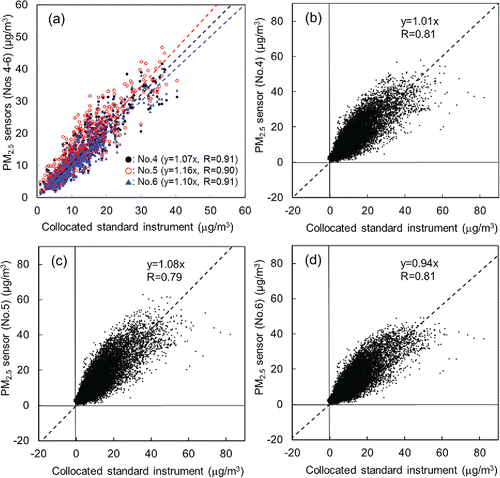
shows temporal variations in 1 min averaged PM2.5 mass concentrations measured with the Panasonic-PM2.5 sensors, as well as 1 h averaged data obtained with the standard instrument at the Kadoma site from 0:00 to 12:00 (Japan Standard Time) on September 13, 2015. It is suggested that the sensors could detect short timescale variations (<5 min) in PM2.5 mass concentrations, for example, at around 0:20 and 11:12 on the day (arrows in ). The variations in the 1 min averaged PM2.5 mass concentrations for each sensor when PM2.5 mass concentrations were stable (for example, from 11:20 to 11:40), were typically less than ±1 μg/m3. These results suggest that the sensors can measure PM2.5 mass concentrations precisely with high temporal resolution.
Figure 6. Temporal variation in 1 min averaged PM2.5 mass concentrations measured with the Panasonic-PM2.5 sensors (Nos. 4–6) and 1 h averaged PM2.5 mass concentrations measured with the collocated standard instrument from 0:00 to 12:00 (Japan Standard Time) on Sep. 13, 2015 at the Kadoma site. Arrows represent sharp changes in the PM2.5 mass concentrations within 5 min.
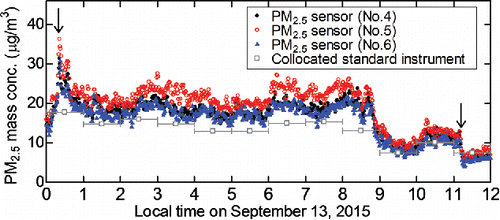
3.3. Comparison with the nearest AEROS data at the four sites
Temporal variations in the averages of daily PM2.5 mass concentrations measured using three Panasonic-PM2.5 sensors at the Fukuoka, Kadoma, Kasugai, and Tokyo sites are shown in Figure S2 in the online SI, with daily PM2.5 mass concentrations observed at the nearest AEROS observatories using standard beta attenuation monitors (). At all the four sites, the PM2.5 sensors and the AEROS data show similar seasonal and day-to-day variations throughout the observation periods. shows scatter plots of the 24 h averaged PM2.5 mass concentrations measured with each PM2.5 sensor and the nearest AEROS data. At all the four sites, the data from the sensors were in good agreement with the AEROS data with slopes of 0.97–1.23 and R of 0.89–0.95.
Figure 7. Scatter plots of 24 h averages of PM2.5 mass concentrations measured with the Panasonic-PM2.5 sensors: (a) Nos. 1–3 at Fukuoka, (b) Nos. 4–6 at Kadoma, (c) Nos. 7–9 at Kasugai, and (d) Nos. 10–12 at Tokyo versus those obtained at the nearest observatories of the AEROS during the observation periods in . Dashed lines represent the results of the linear least-squares fitting analyses.
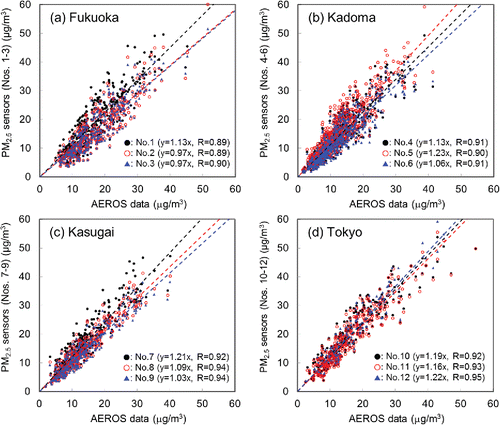
Average PM2.5 mass concentrations from the nearest AEROS data obtained during the common observation period (from Mar. 24, 2015 to Mar. 19, 2016) are 17.3, 12.9, 13.8, and 15.5 μg/m3 at the Fukuoka, Kadoma, Kasugai, and Tokyo sites, respectively. The higher PM2.5 mass concentration at Fukuoka may be partly due to the relatively large influences of particles long-range transported from the Asian continent. The physicochemical and optical properties of the particles may influence the sensitivity of the PM2.5 sensor, as described above. Even though the average characteristics of the physicochemical properties of the particles would be different among the four sites, no significant differences in the slopes for the four distinct sites were observed ().
3.4. Seasonal variation
The physicochemical and optical properties of aerosol particles may vary according to the season at each observation site. During the summer, photochemical reactions would enhance the formation of secondary aerosols. Transboundary air pollution, in which sulfate is a dominant aerosol constituent, is expected to influence the observed PM2.5 mass concentrations, especially at the Fukuoka site during winter and spring (e.g., Aikawa et al. Citation2010; Kaneyasu et al. Citation2014; Yoshino et al. Citation2016).
shows the average ratios of daily PM2.5 mass concentrations measured with the Panasonic-PM2.5 sensors compared to those measured with the standard instruments at the nearest AEROS observatories and with the collocated standard instrument in each season. Note that the data from the sensor No. 12 at the Tokyo site were not used, because this sensor was not operated throughout the year. Although greater contributions of sulfate would be expected at the Fukuoka site compared to the other sites, especially in winter and spring, no significant differences in the ratios for the sites were observed in these seasons. Slightly higher average ratios were observed in winter than in summer, except at the Tokyo site. Photochemical formation of secondary particles with diameters smaller than the detectable size limit of the sensor may be a possible reason for the observed lower ratios in summer. If the RH values in winter were higher than those in summer, hygroscopic growth of the particles might contribute to the higher ratios in winter, as discussed in the following section. However, the average RH values, which were measured in the boxes containing the sensors in winter at all the four sites (50%, 48%, 41%, and 48% at the Fukuoka, Kadoma, Kasugai, and Tokyo sites, respectively) were lower than those in summer (62%, 53%, 53%, and 67% at the Fukuoka, Kadoma, Kasugai, and Tokyo sites, respectively). Therefore, the difference in RH should not be the cause of the slightly higher ratios in winter. The possibility of contributions of seasonal variations in the chemical composition (which contribute to refractive index and density), shape, and morphology of particles cannot be ruled out. Further studies based on simultaneous measurements of PM2.5 mass concentrations and these physicochemical properties are needed for a more detailed understanding of the seasonal variations.
Figure 8. Seasonal variations in the ratios of daily PM2.5 mass concentrations measured with the Panasonic-PM2.5 sensors compared to those measured with the standard instruments at the nearest AEROS observatories at the Fukuoka (filled circles), Kadoma (filled triangles), Kasugai (filled inverted triangles), and Tokyo (filled squares) sites and with the collocated standard instrument at the Kadoma site (open triangles). Standard instrument data with >5 μg/m3 were used in the calculations. Data obtained with the sensors, Nos. 1–3, 4–6, 7–9, and 10–11, were averaged and used for the calculations. Error bars represent 1σ of the ratios in each season.
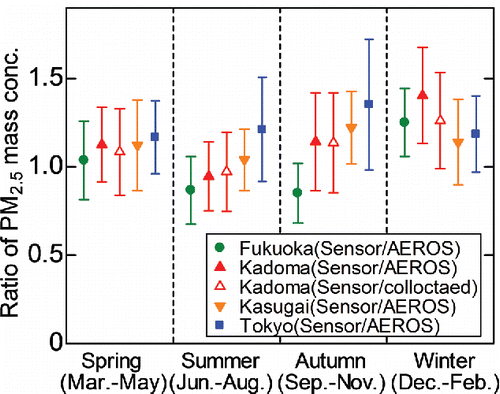
3.5. Influence of RH
The PM2.5 mass concentration in the atmosphere can vary depending on the RH because of the hygroscopic growth of particles. The standard instruments used in the present study are designed to give equivalent values to those determined based on offline weight measurements of filter samples (maintained at a temperature of 21.5 ± 1.5°C and a RH of 35 ± 5% for >24 h) by heating the inlet line or converting the measurement data using an assumed hygroscopic growth curve. In contrast, the Panasonic-PM2.5 sensor does not keep the RH constant, while the heater placed inside the sampling inlet of the sensor would lower the RH to some extent.
shows the RH dependence of the binned average ratios of daily PM2.5 mass concentrations measured with the Panasonic-PM2.5 sensors compared to those measured with the standard instruments at the nearest AEROS observatories and with the collocated standard instrument, where the RH is measured in the box containing the PM2.5 sensors. Higher average ratios were observed at higher RH values, and the PM2.5 sensors overestimate the PM2.5 mass concentrations measured with the standard instruments by about 30%–60% at a RH of 70%–80%, except at the Fukuoka site. Although the reason for the absence of a positive relationship between the ratios and the RH at the Fukuoka site is unclear, the results at the other sites suggest that the influence of the hygroscopic growth of particles on the obtained PM2.5 mass concentrations should be considered when operating the sensors at high RH, especially >70%.
Figure 9. RH dependencies of binned average ratios of daily PM2.5 mass concentrations measured with the Panasonic-PM2.5 sensors compared to those measured with the standard instruments at the nearest AEROS observatories at the Fukuoka (filled circles), Kadoma (filled triangles), Kasugai (filled inverted triangles), and Tokyo (filled squares) sites and with the collocated standard instrument at the Kadoma site (open triangles). The data used in the calculation were the same as those in . The error bars represent 1σ of the ratios in each bin.

4. Conclusions
We have developed a palm-sized optical PM2.5 (Panasonic-PM2.5) sensor. By detecting light scattering from particles with diameters as small as ∼0.3 μm and estimating the particle size from the magnitude of scattering signals, PM2.5 mass concentrations are determined. The results of laboratory experiments using cigarette smoke particles indicated that the sensors can measure PM2.5 mass concentrations as high as ∼600 μg/m3 with constant sensitivity, and the sensor-to-sensor variation in the sensitivity is typically less than 10%.
Field observation tests were conducted at four urban and suburban sites, Fukuoka, Kadoma, Kasugai, and Tokyo in Japan. The PM2.5 mass concentrations measured using the Panasonic-PM2.5 sensor were compared to the corresponding data measured using the collocated standard instrument (Thermo Fisher Scientific, model SHARP 5030) at the Kadoma site and those measured using two types of standard beta attenuation monitors at the nearest AEROS observatories, 1.7–4.1 km away from our observation sites. The results of the comparisons suggested that the Panasonic-PM2.5 sensor can provide reasonable PM2.5 mass concentration data in urban and suburban environments. Daily averaged PM2.5 mass concentration data from the sensors were in good agreement with corresponding data from the collocated standard instrument at the Kadoma site, with slopes of 1.07–1.16 and R of 0.90–0.91, and with the nearest AEROS data from the four sites, with slopes of 0.97–1.23 and R of 0.89–0.95. The sensor has a tendency to slightly underestimate the PM2.5 mass concentrations compared to those measured with the standard instruments in summer except at the Tokyo site, possibly due to the photochemical formation of relatively small secondary particles. The sensor also has a tendency to overestimate the PM2.5 mass concentrations compared to those measured with the standard instruments under high RH conditions (>70%) except at the Fukuoka site, which is possibly due to the hygroscopic growth of particles.
The PM2.5 sensor offers several advantages including small size, low power consumption, low cost, high temporal resolution, and ease of operation. This study demonstrates that the sensor will be applicable to the multi-point and mobile measurements, as well as observations near an emission source and in developing countries. These data will provide valuable information on the environmental and health effects of aerosol particles.
Acknowledgments
The authors thank the Ministry of the Environment of Japan for providing the PM2.5 mass concentration data obtained at the AEROS observatories. We acknowledge Prof. K Osada (Nagoya Univ.) and Dr. F. Ikemori (Nagoya City Institute for Environmental Sciences) for their valuable comments.
Funding
This work was partly supported by the Grant-In-Aid for Scientific Research (KAKENHI 16H02936, 16K12581, 25701001) from the Ministry of Education, Culture, Sports, Science and Technology (MEXT) and the Environment Research and Technology Development Fund (5-1604) of the Ministry of the Environment, Japan.
References
- ACAP. (2015). Monitoring of PM2.5 Experience in Japan, Japan Environmental Sanitation Center: Asia Center for Air Pollution Research publication, Available at http://www.acap.asia/publication/index.html.
- Aikawa, M., Ohara, T., Hiraki, T., Oishi, O., Tsuji, A., Yamagami, M., Murano, K., and Mukai, H. (2010). Significant Geographic Gradients in Particulate Sulfate Over Japan Determined from Multiple-Site Measurements and a Chemical Transport Model: Impacts of Transboundary Pollution from the Asian Continent. Atmos. Environ., 44:381–391.
- Akimoto, H. (2017). Overview of Policy Actions and Observational Data for PM2.5 and O3 in Japan: A Study of Urban Air Quality Improvement in Asia. JICA Research Institute Working Paper, 137:1–19.
- Alvarado, M., Gonzalez, F., Fletcher, A., and Doshi, A. (2015). Towards the Development of a Low Cost Airborne Sensing System to Monitor Dust Particles after Blasting at Open-Pit Mine Sites. Sensors, 15:19667–19687.
- Austin, E., Novosselov, I., Seto, E., and Yost, M. G. (2015). Laboratory Evaluation of the Shinyei PPD42NS Low-Cost Particulate Matter Sensor. PLoS ONE, 10:e0137789.
- Boucher, O. (2015). Atmospheric Aerosols: Properties and Climate Impacts. Springer, New York.
- Dacunto, P. J., Klepeis, N. E., Cheng, K.-C., Acevedo-Bolton, V., Jiang, R.-T., Repace, J. L., Ott, W. R., and Hildemann, L. M. (2015). Determining PM2.5 Calibration Curves for a Low-Cost Particle Monitor: Common Indoor Residential Aerosols. Environ. Sci.: Processes Impacts, 17:1959–1966.
- EPA. (2013). National Ambient Air Quality Standards for Particulate Matter; Final Rule. Federal Register of Environmental Protection Agency, USA, 78:3086–3287.
- Gao, M., Cao, J., and Seto, E. (2015). A Distributed Network of Low-Cost Continuous Reading Sensors to Measure Spatiotemporal Variations of PM2.5 in Xi'an, China. Environ. Pollut., 199:56–65.
- Han, I., Symanski, E., and Stock, T. H. (2016). Feasibility of Using Low-Cost Portable Particle Monitors for Measurement of Fine and Coarse Particulate Matter in Urban Ambient Air. J. Air Waste Manage. Assoc., 67:330–340.
- Holstius, D. M., Pillarisetti, A., Smith, K. R., and Seto, E. (2014). Field Calibrations of a Low-Cost Aerosol Sensor at a Regulatory Monitoring Site in California. Atmos. Meas. Tech., 7:1121–1131.
- Hu, M., Peng, J., Sun, K., Yue, D., Guo, S., Wiedensohler, A., and Wu, Z. (2012). Estimation of Size-Resolved Ambient Particle Density Based on the Measurement of Aerosol Number, Mass, and Chemical Size Distributions in the Winter in Beijing. Environ. Sci. Technol., 46:9941–9947.
- Jiao, W., Hagler, G., Williams, R., Sharpe, , Weinstock, L., and Rice, J. (2015). Field Assessment of the Village Green Project: An Autonomous Community Air Quality Monitoring System. Environ. Sci. Technol., 49:6085–6092.
- Jiao, W., Hagler, G., Williams, R., Sharpe, R., Brown, R., Garver, D., Judge, R., Caudill, M., Rickard, J., Davis, M., Weinstock, L., Zimmer-Dauphinee, S., and Buckley, K. (2016) Community Air Sensor Network (CAIRSENSE) Project: Evaluation of Low-Cost Sensor Performance in a Suburban Environment in the Southeastern United States. Atmos. Meas. Tech., 9:5281–5292.
- Johnson, T., Olfert, J., Cabot, R., Treacy, C., Yurteri, C., Dickens, C., McAughey, J., and Symonds, J. (2014). Steady-State Measurement of the Effective Particle Density of Cigarette Smoke. J. Aerosol Sci., 75:9–16.
- Kaneyasu, N., Yamamoto, S., Sato, K., Takami, A., Hayashi, M., Hara, K., Kawamoto, K., Okuda, T., and Hatakeyama, S. (2014). Impact of Long-Range Transport of Aerosols on the PM2.5 Composition at a Major Metropolitan Area in the Northern Kyushu Area of Japan. Atmos. Environ., 97:416–425.
- Kaufman, A., Brown, A., Barzyk, T., and Williams, R. (2014). The Citizen Science Toolbox: A One-Stop Resource for Air Sensor Technology. EM, September:48–49.
- Kelly, K. E., Whitaker, J., Petty, A., Widmer, C., Dybwad, A., Sleeth, D., Martin, R., and Butterfield, A. (2017). Ambient and Laboratory Evaluation of a Low-Cost Particulate Matter Sensor. Environ. Pollut., 221:491–500.
- Kulkarni, P., Baron, P. A., and Willeke, K. (2011). Aerosol Measurement: Principles, Techniques, and Applications, 3rd ed., John Wiley & Sons, Inc, Hoboken, NJ.
- Lelieveld, J., Evans, J. S., Fnais, M., Giannadaki, D., and Pozzer, A. (2015). The Contribution of Outdoor Air Pollution Sources to Premature Mortality on a Global Scale. Nature, 525:367–371.
- Lewis, A., and Edwards, P. (2016). Validate Personal Air-Pollution Sensors. Nature, 535:29–31.
- Lipowicz, P. J. (1988). Determination of Cigarette Smoke Particle Density from Mass and Mobility Measurements in a Millikan Cell. J. Aerosol Sci., 19:587–589.
- Manikonda, A., Zíková, N., Hopke, P. K., and Ferro, A. R. (2016). Laboratory Assessment of Low-Cost PM Monitors. J. Aerosol Sci., 102:29–40.
- McMurry, P. H., Wang, X., Park, K., and Ehara, K. (2002).The Relationship Between Mass and Mobility for Atmospheric Particles: A New Technique for Measuring Particle Density. Aerosol Sci. Technol., 36:227–238.
- MOEJ (2015). On Equivalence Evaluation of PM2.5 Automatic Measurement Instruments. Ministry of the Environment, Japan, http://www.env.go.jp/air/osen/pm/parallelexam/index.html.
- Mueller, M. D., Hasenfratz, D., Saukh, O., Fierz, M., and Hueglin, C. (2016). Statistical Modelling of Particle Number Concentration in Zurich at High Spatio-Temporal Resolution Utilizing Data from a Mobile Sensor Network. Atmos. Environ., 126:171–181.
- Nakagawa, M., Nakayama, T., Sasago, H., Ueda, S., Venables, D. S., and Matsumi, Y. (2016). Design and Characterization of a Novel Single-Particle Polar Nephelometer. Aerosol Sci. Technol., 50:392–404.
- Nakayama, T., Kondo, Y., Moteki, N., Sahu, L. K., Kinase, T., Kita, K., and Matsumi, Y. (2010). Size-Dependent Correction Factors for Absorption Measurements Using Filter-Based Photometers: PSAP and COSMOS. J. Aerosol Sci., 41:333–343.
- Nakayama, T., Ikeda, Y., Sawada, Y., Setoguchi, Y., Ogawa, S., Kawana, K., Mochida, M., Ikemori, F., Matsumoto, K., and Matsumi, Y. (2014). Properties of Light-Absorbing Aerosols in the Nagoya Urban Area, Japan, in August 2011 and January 2012: Contributions of Brown Carbon and Lensing Effect. J. Geophys. Res. Atmos., 119:12721–12739.
- Nakayama, T., Suzuki, H., Kagamitani, S., Ikeda, Y., Uchiyama, A., and Matsumi, Y. (2015). Characterization of a Three Wavelength Photoacoustic Soot Spectrometer (PASS-3) and a Photoacoustic Extinctiometer (PAX). J. Meteorol. Soc. Jpn., 93:285–308.
- Northcross, A. L., Edwards, R. J., Johnson, M. A., Wang, Z. –M., Zhu, K., Allen, T., and Smith, K. R. (2013). A Low-Cost Particle Counter as a Realtime Fine-Particle Mass Monitor. Environ. Sci.: Processes Impacts, 15:433–439.
- Patel, S., Li, J., Pandey, A., Pervez, S., and Chakrabarty, R. K., and Biswasa, P. (2017). Spatio-Temporal Measurement of Indoor Particulate Matter Concentrations Using a Wireless Network of Low-Cost Sensors in Households Using Solid Fuels. Environ Res., 152:59–65.
- Seinfeld, J.H. and Pandis, S.N. (2016). Atmospheric Chemistry and Physics: From Air Pollution to Climate Change, 3rd ed. John Wiley & Sons, Inc, Hoboken, NJ.
- Snyder, E. G., Watkins, T. H., Solomon, P. A., Thoma, E. D., Williams, R. W., Hagler, G. S. W., Shelow, D., Hindin, D. A., Kilaru, V. J., and Preuss, P. W. (2013). The Changing Paradigm of Air Pollution Monitoring. Environ. Sci. Technol., 47:11369–11377.
- Sousan, S., Koehler, K., Thomas, G., Park, J. H., Hillman, M., Halterman, A., and Peters, T. M. (2016). Inter-Comparison of Low-Cost Sensors for Measuring the Mass Concentration of Occupational Aerosols. Aerosol Sci. Technol., 50:462–473.
- Spencer, M. T., Shields, L. G., and Prather, K. A. (2007). Simultaneous Measurement of the Effective Density and Chemical Composition of Ambient Aerosol Particles. Environ. Sci. Technol., 41:1303–1309.
- Steinle, S., Reis, S., Sabel, C. E., Semple, S., Twigg, M. M., Braban, C. F., Leeson, S. R., Heal, M. R., Harrison, D., Lin, C. and Wu, H. (2015). Personal Exposure Monitoring of PM2.5 in Indoor and Outdoor Microenvironments. Sci. Total Environ., 508:383–394.
- Wallace, L. A., Wheeler, A. J., Kearney, J., Ryswyk, K. V., You, H., Kulka, R. H., Rasmussen, P. E., Brook, J. R., and Xu, X. (2011). Validation of Continuous Particle Monitors for Personal, Indoor, and Outdoor Exposures. J. Expo. Sci. Environ. Epidemiol., 21:49–64.
- Wang, Y., Li, J., Jing, H., Zhang, Q., Jiang, J., and Biswas, P. (2015). Laboratory Evaluation and Calibration of Three Low-Cost Particle Sensors for Particulate Matter Measurement. Aerosol Sci. Technol., 49:1063–1077.
- Williams, R., Kaufman, A., Hanley, T., Rice, J., and Garvey. S. (2014). Evaluation of Field-Deployed Low Cost PM Sensors. U.S. Environmental Protection Agency, Washington, DC, EPA/600/R-14/464 (NTIS PB 2015–102104).
- Yin, Z., Ye, X., Jiang, S., Tao, Y., Shi, Y., Ynag, X., and Chen, J. (2015). Size-Resolved Effective Density of Urban Aerosols in Shanghai. Atmos. Environ., 100:133–140.
- Yoshino, A., Takami, A., Sato, K., Shimizu, A., Kaneyasu, N., Hatakeyama, S., Hara, K., and Hayashi, M. (2016). Influence of Trans-Boundary Air Pollution on the Urban Atmosphere in Fukuoka, Japan. Atmosphere, 7:51.
- Zhang, G., Bi, X., Qiu, N., Han, B., Lin, Q., Peng, L., Chen, D., Wang, X., Peng, P., Sheng, G., and Zhou, Z. (2016). The Real Part of the Refractive Indices and Effective Densities for Chemically Segregated Ambient Aerosols in Guangzhou Measured by a Single-Particle Aerosol Mass Spectrometer. Atmos. Chem. Phys., 16:2631–2640.
- Zhang, Q., Jiang, X., Tong, D., Davis, S. J., Zhao, H., Geng, G., Feng, T., Zheng, B., Lu, Z., Streets, D. G., Ni, R., Brauer, M., van Donkelaar, A., Martin, R. V., Huo, H., Liu, Z., Pan, D., Kan, H., Yan, Y., Lin, J., He, K., and Guan, D. (2017). Transboundary Health Impacts of Transported Global Air Pollution and International Trade. Nature, 543:705–709.
- Zhao, S., Yu, Y., Yin, D., and He, J. (2017). Effective Density of Submicron Aerosol Particles in a Typical Valley City, Western China. Aerosol Air Qual. Res., 17:1–13.
- Zikova, N., Hopke, P. K., and Ferro, A. R. (2017). Evaluation of New Low-Cost Particle Monitors for PM2.5 Concentrations Measurements. J. Aerosol Sci., 105:24–34.

